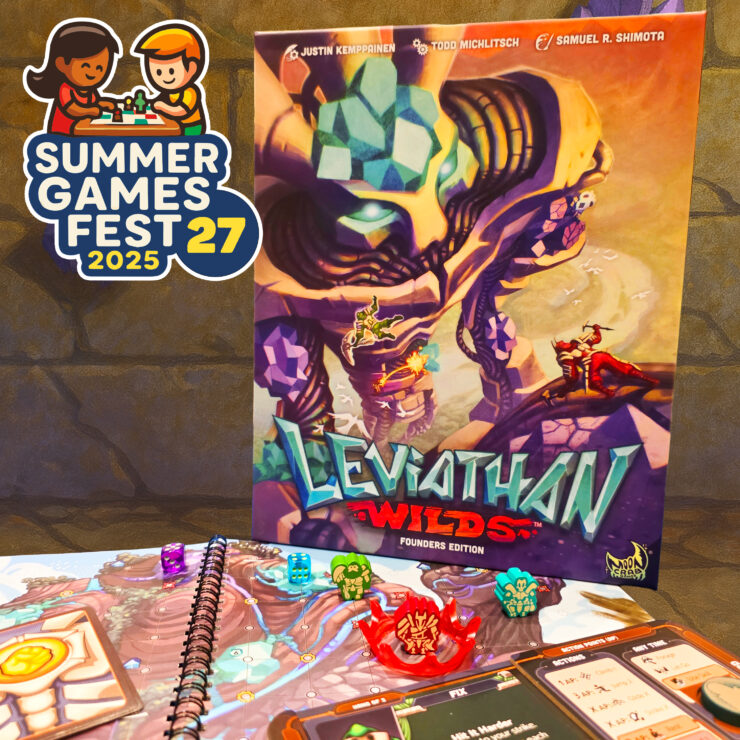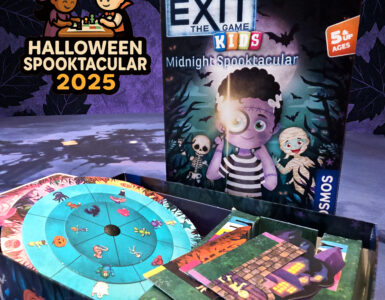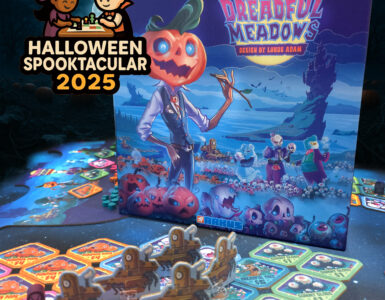I’ve always loved dungeon crawlers, and so have the boys. One of the games that first got me realising I could play more complex games with my children, provided we played them co-op, was Gloomhaven: Jaws of the Lion. I successfully navigated it with my three and five-year-old during lockdown. An offshoot of that genre is boss battling, where rather than going through a dungeon and fighting waves of enemies, you instead face one big enemy, usually in some sort of arena.
Probably the most famous games in the genre are Oathsworn and Kingdom Death: Monster, but both are incredibly complex and in the case of Kingdom Death, incredibly expensive, with the base set coming in at around £400 and expansions around £150 each.
Today, though, we’re looking at something much more affordable, and something that aims to bring the concept of boss battling to a more family-friendly audience. With that, I present Leviathan Wilds, my new recommendation for getting into the boss battling genre
Theme and Concept
The story of Leviathan Wilds is that, long ago, the once-gentle leviathans lost their minds and tore the world apart. After generations of humanity hiding and struggling, it was finally discovered that the leviathans had been corrupted by strange crystals growing all over their bodies. These crystalline growths can be destroyed to return the leviathans to their once more timid selves.
You and your companions play as a team of climbers who are trying to scale the leviathans and destroy the crystals.
Complexity and Accessibility
Leviathan Wilds is fairly complex in terms of detail, but a lot of it can be taught as you go. I’ll give you a rough overview here. As long as you have an adult to help younger players, you can enjoy this with surprisingly young children. I’ve played it with Toby and Jack, and both had absolutely no problems. The box suggests 10+, but you could easily play this with a six-year-old who can read and is keen to get involved, especially as it’s fully cooperative, so you can help as much as needed.
How It Works
You start by choosing a leviathan, this is the monster you’re going to fight. Depending on which one you choose, the board layout will be slightly different, and the cards and abilities in the threat deck (which determines what the monster does each round) will also change. The monsters are found in a beautiful Book of Leviathans inside the box, and the artwork is lovely. I really like games that come with booklets. As far as I’m concerned, all legacy games and dungeon crawlers should use books instead of loads of tiles. I get the argument for tiles giving more flexibility, but just give me the book.
You also get to choose your difficulty, which is a really nice touch. We played a few games on easy to start with, then tried some on normal, just to get a feel for it. While the difficulty ramps up, it still felt very fair.

Building Your Character
You build your deck based on the character and class you choose. Each class comes with a set of cards, and each character comes with two extra cards. You combine the two to create your personal deck. This is great because it allows for a bit of customisation. For example, I really liked playing as a mobile class that gave me loads of movement, and I paired it with a character who had a bonus to attack. It gave me the best of both worlds.
Some classes are more complex than others, and some have extra traits or abilities to explore once you’re more confident. Your characters are represented by meeples, which you place at the base of the leviathan. Then you’re ready to go.
Health, Corruption and Turn Order
Your player board has two tracks, one for health and one for corruption. Every time you lose health, you move your health token to the right. Every time you gain corruption, you move your corruption token to the left. If the two ever meet, your climber is knocked out and the mission fails.
Each turn starts with revealing a threat card, which shows what the monster is going to do later that turn. This could be damaging the lead player, causing everyone to lose grip, or spreading corruption. Then it’s your chance to move and take actions to try and avoid or mitigate that threat.
After everyone has acted, the threat resolves. Finally, you draw back up to three cards. It’s a really clever system, you know what’s coming, and then you get to plan how to deal with it.

Cards and Abilities
On your turn, you choose one card to use for its ability points. Each card also provides some protection — it might make you immune to damage, grip loss, or corruption. This is important if the upcoming threat involves one of those effects.
You don’t get to use the ability printed on the card you play for points, only the points themselves. But you can then spend those points to play other cards, which allow you to move, attack crystals, or use special effects.
Once you’ve acted, the threat happens, and you draw back up to three cards.
Falling, Resting and Strategy
There are a few ways your climber can fall, for example, if you run out of cards, or if a threat knocks you down. When you fall, you slide down vertically, taking damage or corruption based on what you pass through on the way. Sometimes, falling tactically is actually helpful, especially if you need to get somewhere quickly and know the fall won’t hurt too much. You can also rest on a ledge to recover cards, which is vital for managing your hand.
As you climb, you’ll lose grip (forcing you to discard cards from your deck) and encounter other twists and obstacles. Each leviathan introduces its own surprises, which I won’t spoil here, because discovering what each one does is part of the fun.
Replayability and Campaign Style
Just to be clear, Leviathan Wilds is not a legacy game. You can fight the leviathans in any order, and play them as many times as you like. In some ways, that’s a real bonus. Some leviathans were definitely more appealing to my kids than others.

Components
Component quality is excellent without being over the top, which helps keep the price reasonable. The meeples are great, the board is solid, and everything looks good on the table. I have the Kickstarter Founders Edition with deluxe components, so if you go for the standard retail version, expect some cardboard tokens rather than fancier ones but what you see here is largely what you’ll get. The box is a sensible size, just a bit bigger than Carcassonne, but smaller than Ticket to Ride.
Final Thoughts
We had a fantastic time with the games of Leviathan Wilds that we played, and we fully intend to keep going with it through the summer. In fact, it’s the first game we’ve played during Summer Games Fest where the kids immediately asked when we were going to play it again. That’s always a brilliant sign.
If you’re looking for something cooperative, something a bit like a dungeon crawler (but without combat), something where the aim is to heal rather than hurt with fun adventure, clever deck-building and proper family strategy, then Leviathan Wilds is a brilliant entry point. Highly recommended.














